Although there were fluctuations on the bond markets last month, there was little change overall month-on-month.
You are here:
Market overview: Optimism on the financial markets crumbles
Optimism on the financial markets took a hit last month. In particular, the high level of investment in artificial intelligence and the limited breadth of market and margin development have attracted greater attention during the reporting season and are being viewed with increasing scepticism.
Indexed performance of government bonds in local currency
100 = 01.01.2025
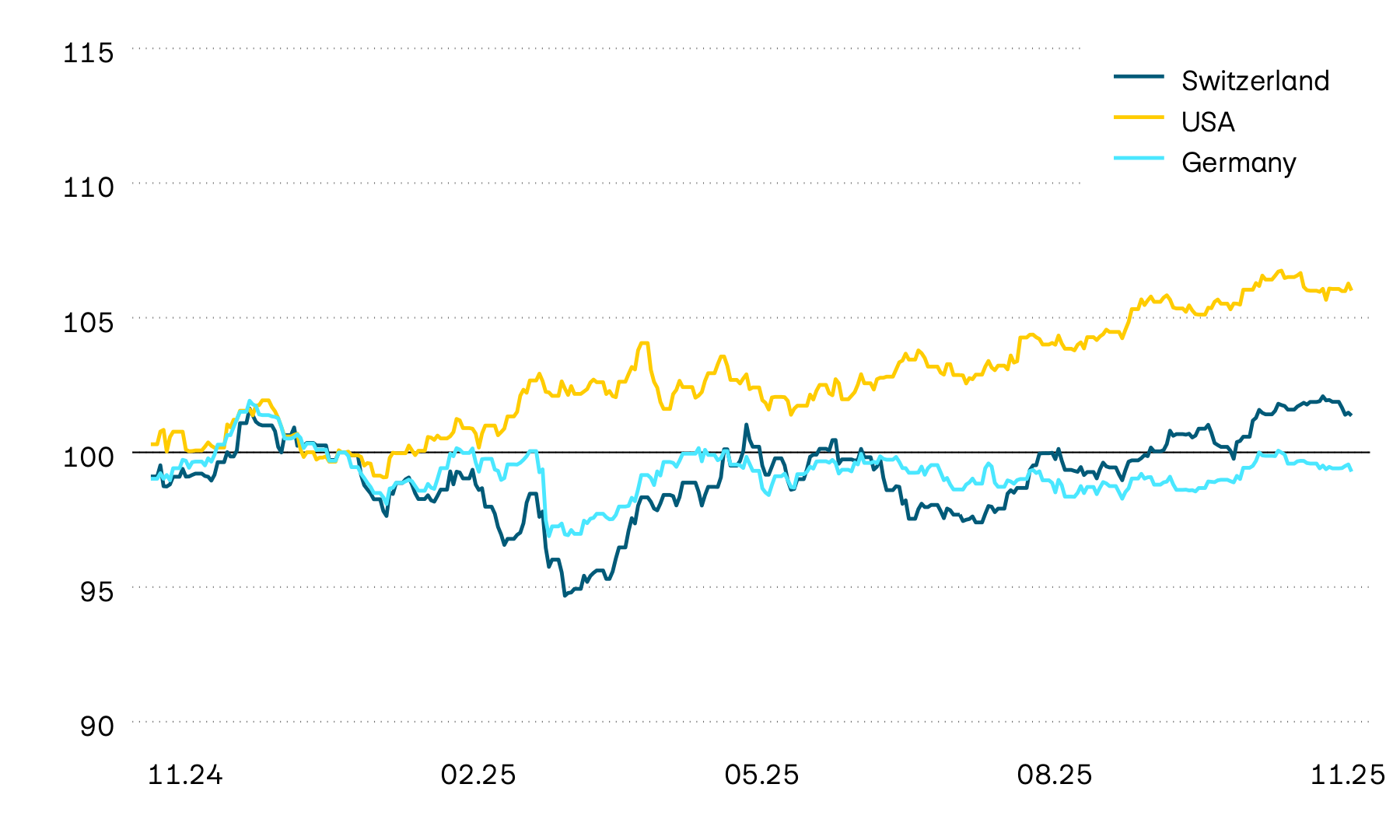
The bond markets experienced fluctuations in October, but ultimately remained virtually unchanged month-on-month. They rose sharply in the first half of the month following relatively weak labour market data from the USA. There was another downturn towards the end of the month, however, due to an interest rate decision in the USA. As expected, the US Federal Reserve cut the policy rate by 25 basis points for the second time this year. Once again, it became clear how differently the US monetary policy committee members view the inflation situation, which dampened market participants’ expectations of a further key interest rate cut in December. Monetary policy decisions were also pending in Europe and Japan. As expected, the central banks left their policy rates unchanged. In Europe, inflation has remained slightly above the European Central Bank’s target since the summer, so a policy rate cut would have come as a surprise. Inflation also remains high in Japan, but the central bank still opposes a more restrictive monetary policy.
Trend in 10-year yields to maturity
In percent
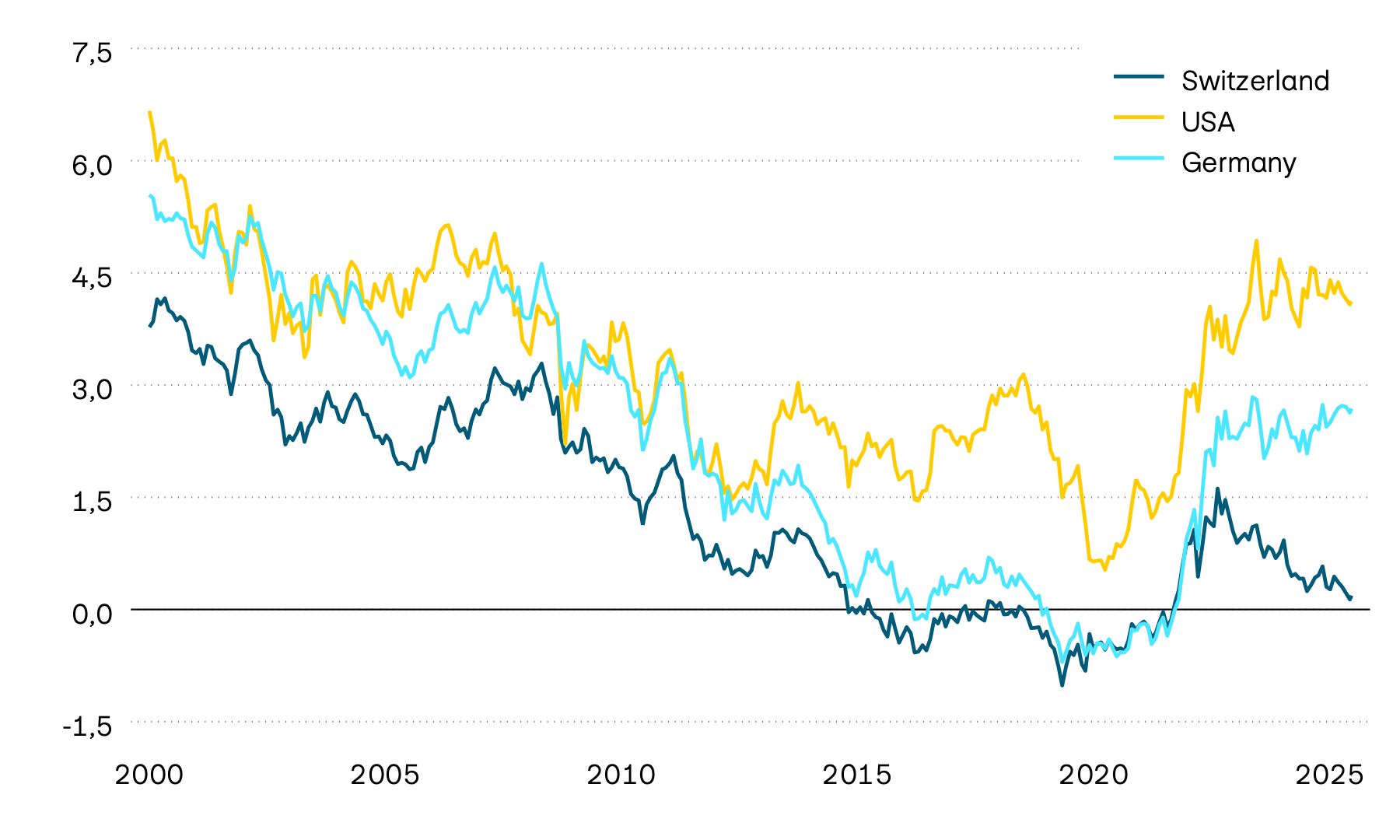
Yields to maturity on long-term government bonds remained broadly stable worldwide compared to the previous month. However, there were stronger fluctuations during the month. In mid-October, yields to maturity on 10-year US government bonds reached their lowest level since April, at 3.9 percent. Towards the end of October, however, there was a countermove, which was likely driven by uncertainty about further interest rate cuts by the US Federal Reserve and more positive market sentiment. In Switzerland, yields to maturity on Swiss federal bonds remained unchanged from the previous month, at just under 0.2 percent.
Credit spreads on corporate bonds
In percentage points
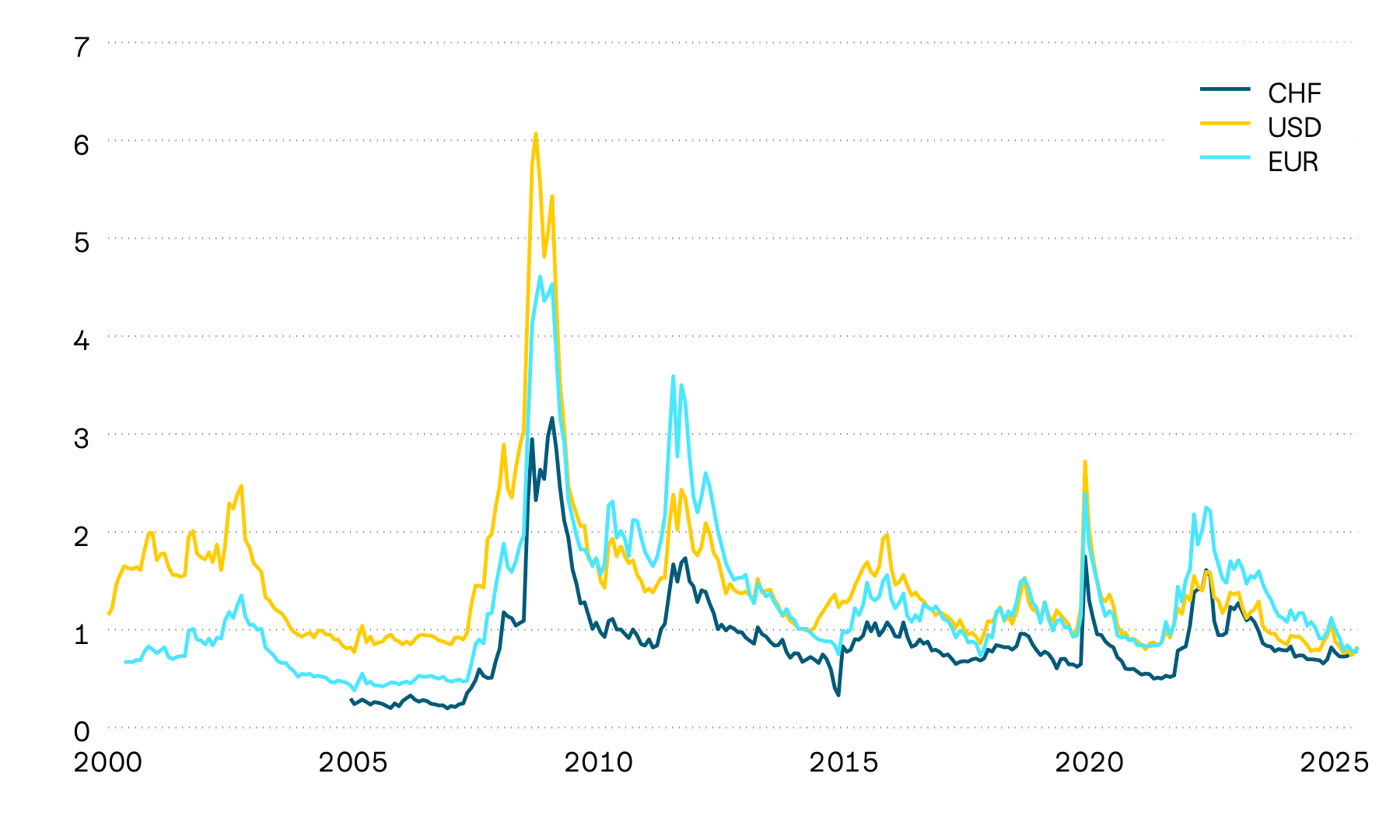
Credit spreads on corporate bonds remain at historically low levels. They rose slightly again at the end of October, probably due in large part to the increase in yields to maturity on the government bond market. Overall, however, fears of recession on the corporate bond market are still low.
The equity markets made further gains last month. However, this rise in value is coming under growing pressure. Concerns over the high level of investment in artificial intelligence are becoming increasingly prominent, weighing noticeably on the markets recently.
Indexed stock market performance in Swiss francs
100 = 01.01.2025
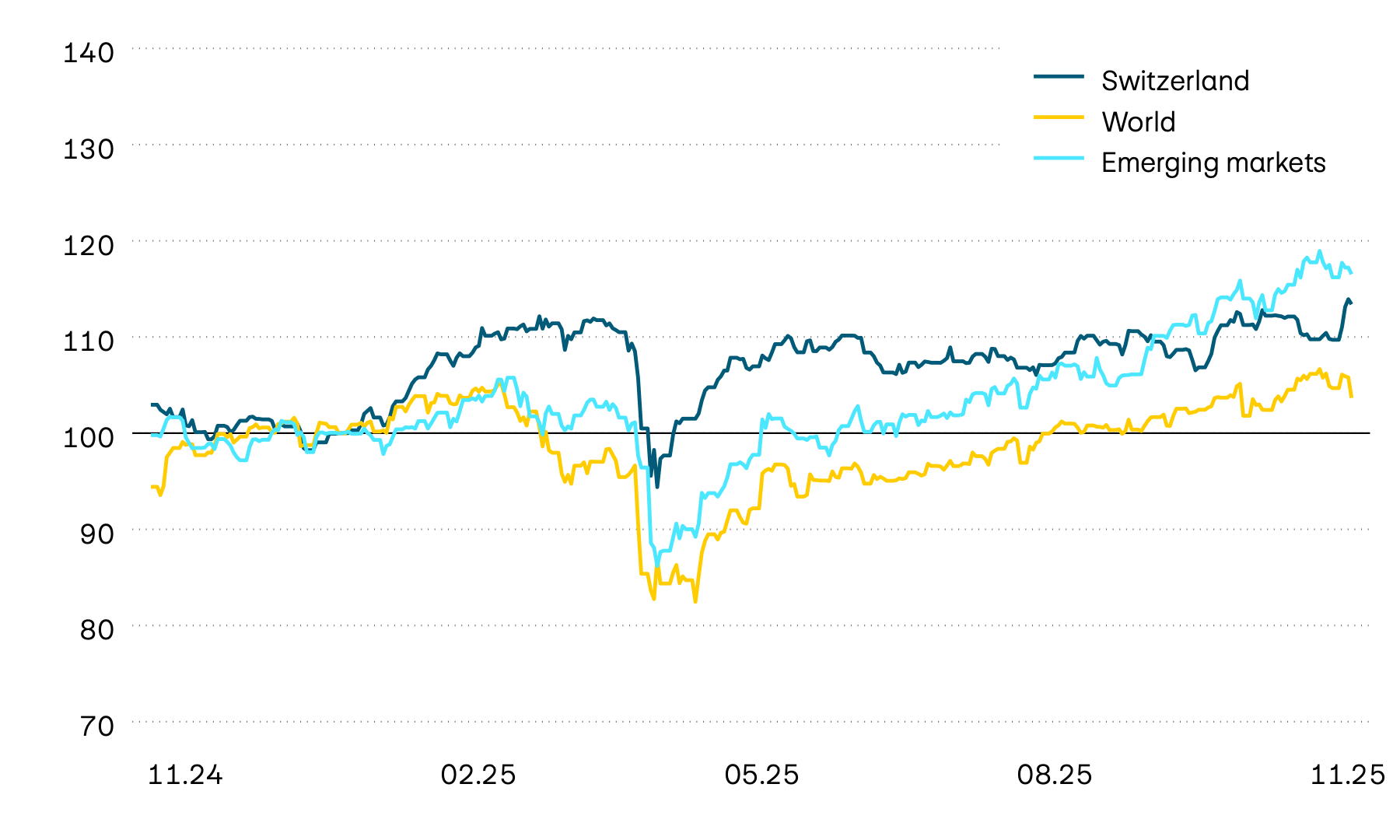
The equity markets confirmed their upward trend last month. In the USA, tech stocks helped the equity market to make strong gains, especially in the first half of October. Towards the end of the month, however, concerns about high investments in artificial intelligence and generally high valuations led to a decline. In Switzerland, the quarterly results of index heavyweights Roche and Novartis initially weighed on market performance. However, there was a significant recovery in November, due to developments in the trade dispute with the USA. According to the memorandum of understanding signed during the month, tariffs for Swiss companies will fall from 39 to 15 percent. Once again, emerging market equities made the strongest gains last month.
Momentum of individual markets
In percent
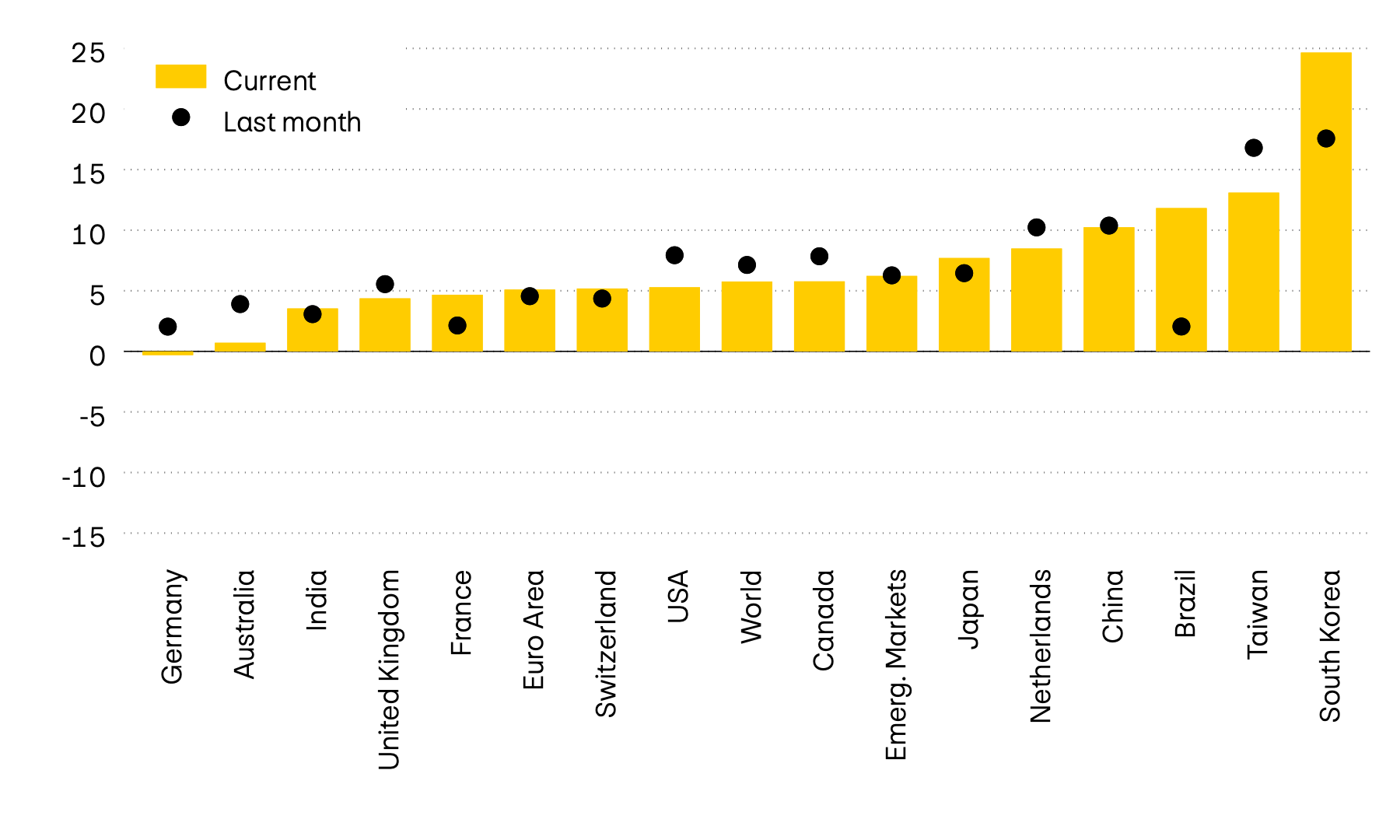
Momentum on the equity markets is still predominantly positive. Only momentum on the German equity market turned negative this month. Once again, the South Korean equity market has proved exceptional. The two companies Samsung Electronics and SK Hynix, which account for almost half of the local index, contributed significantly to returns with their strong performance following new product announcements. Overall, the euphoria surrounding the positive developments in artificial intelligence once again pushed the tech-dominated markets to positive gains this month, even though sentiment has recently shifted somewhat and the previously high level of confidence has waned.
Price/earnings ratio

The price/earnings ratio rose sharply again last month due to another upswing in prices on most markets. This is currently causing increased concern in the USA. Tech stocks are all very highly rated, and companies are spending enormous amounts of money in the AI race, which has recently caused some unease among investors. A look ahead to the reporting season is likely to exacerbate these concerns. Although profit figures are positive again, they are almost entirely driven by the tech sector.
Although prices came under pressure in early November, exchange-listed Swiss real estate funds made further gains last month.
Indexed performance of Swiss real estate funds
100 = 01.01.2025
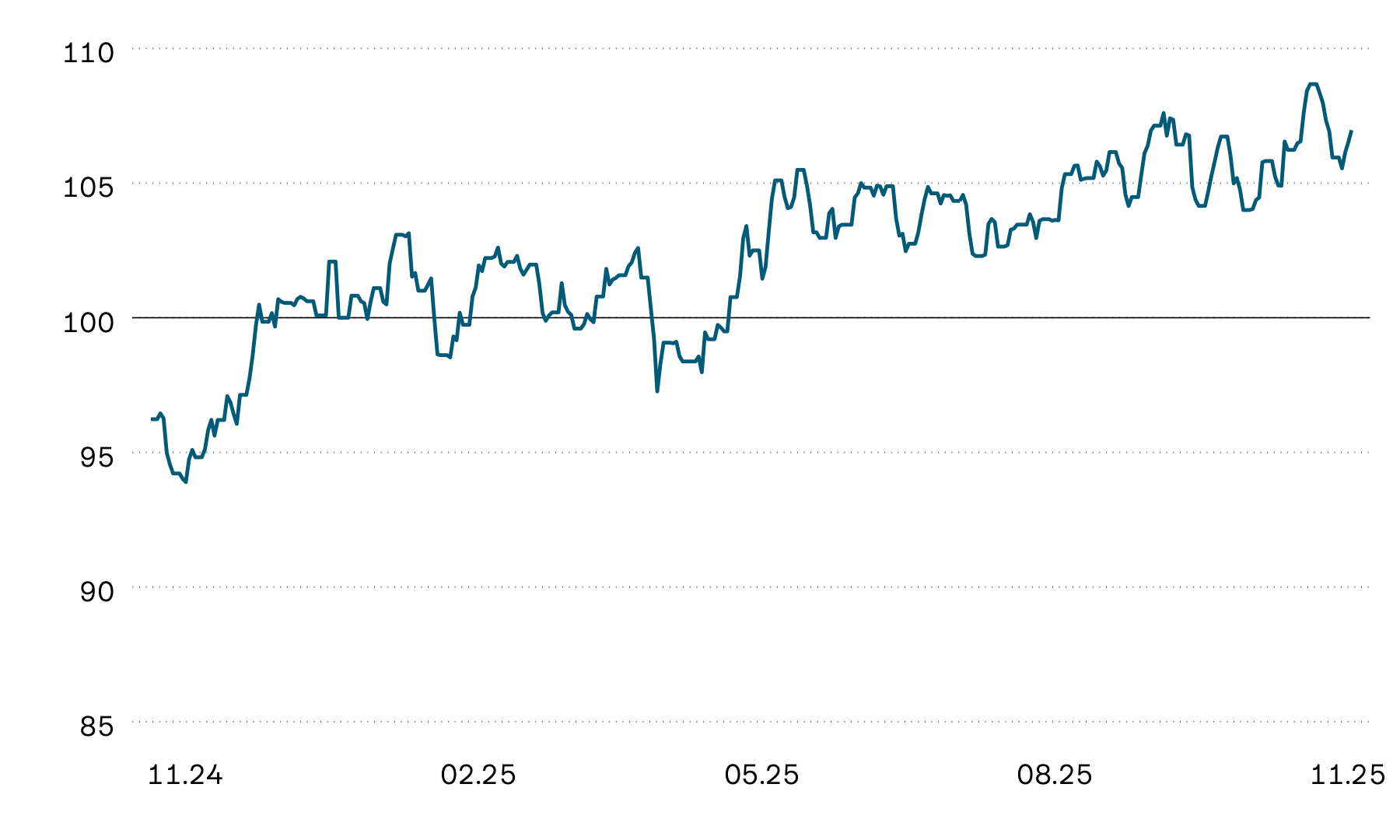
The prices of exchange-listed Swiss real estate funds rose month-on-month, although they were significantly higher at the end of October. Prices came under particular pressure in November. This is likely due partly to subdued market sentiment and partly to UBS’s announced merger of several Swiss real estate funds, which may have triggered uncertainty regarding premiums or discounts and fund structure.
Premium on Swiss real estate funds and 10-year yields to maturity
In percent
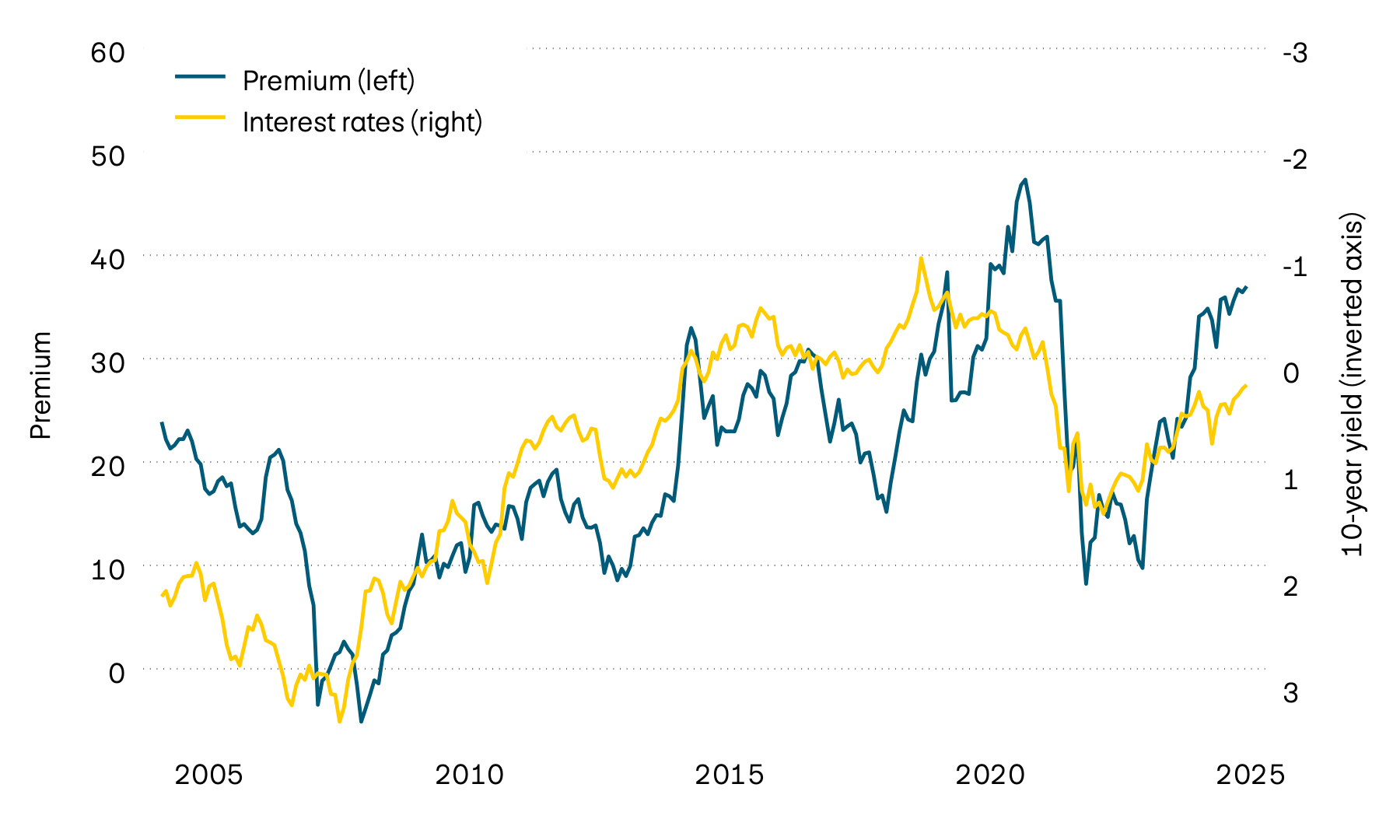
As in the previous month, premiums – the premium investors pay on the stock exchange compared to the net asset value of the properties – rose again last month. This is likely to be due mainly to the rise in prices of Swiss real estate funds. Premiums have been on a clear upward trend since April and are reaching levels previously seen only during periods of negative capital market interest rates.
3-month SARON and 10-year yields to maturity
In percent
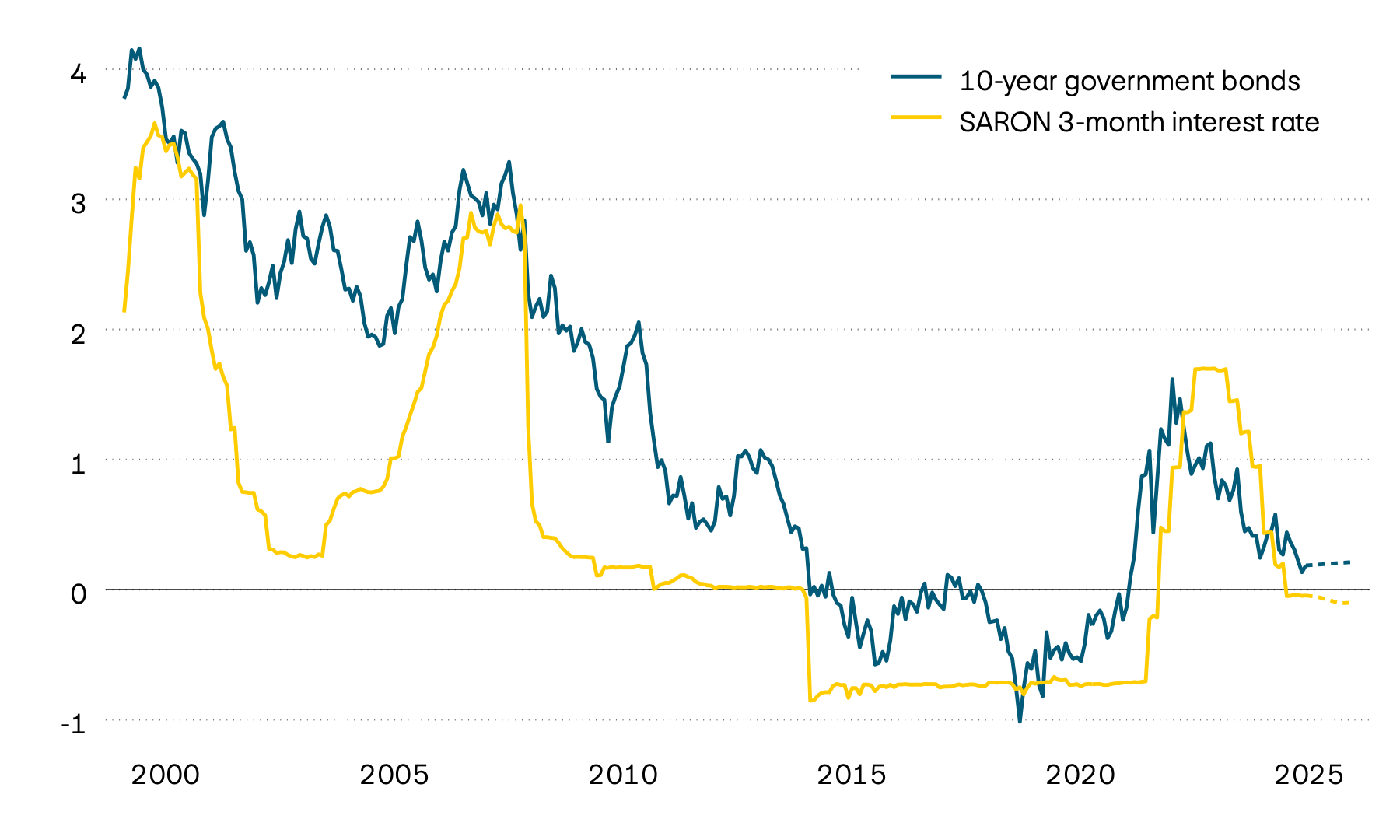
Yields to maturity on 10-year Swiss government bonds remain close to the zero interest limit. In light of the lower core inflation rate of 0.5 percent and continued easing of inflationary pressure, attention is starting to turn back to negative interest rates. However, the majority of market participants are not expecting negative interest rates again until next year.
Currencies
The precious metal gold hit a new all-time high last month, while the US dollar continued to trade at a much lower level than at the start of the year.
| Currency pair | Price | PPP | Neutral range | Valuation |
|---|---|---|---|---|
| Currency pair EUR/CHF |
Price 0.92 |
PPP 0.92 |
Neutral range 0.85 – 0.99 |
Valuation Euro neutral |
| Currency pair USD/CHF |
Price 0.79 |
PPP 0.79 |
Neutral range 0.69 – 0.89 |
Valuation USD neutral |
| Currency pair GBP/CHF |
Price 1.05 |
PPP 1.13 |
Neutral range 0.98 – 1.28 |
Valuation Pound sterling neutral |
| Currency pair JPY/CHF |
Price 0.51 |
PPP 0.84 |
Neutral range 0.68 – 1.01 |
Valuation Yen undervalued |
| Currency pair SEK/CHF |
Price 8.43 |
PPP 9.87 |
Neutral range 8.82 – 10.92 |
Valuation Krona undervalued |
| Currency pair NOK/CHF |
Price 7.90 |
PPP 10.44 |
Neutral range 9.18 – 11.70 |
Valuation Krone undervalued |
| Currency pair EUR/USD |
Price 1.16 |
PPP 1.17 |
Neutral range 1.02 – 1.32 |
Valuation Euro neutral |
| Currency pair USD/JPY |
Price 154.57 |
PPP 93.41 |
Neutral range 71.21 – 115.61 |
Valuation Yen undervalued |
| Currency pair USD/CNY |
Price 7.10 |
PPP 6.34 |
Neutral range 5.84 – 6.83 |
Valuation Renminbi undervalued |
Source: Allfunds Tech Solutions
In mid-October, the US dollar appreciated by around 3 percent against most currencies, including the Swiss franc and the euro. However, the appreciation did not last long, and the US dollar lost these gains towards the end of the month. The performance of the euro against the Swiss franc is also striking. The euro traded within a narrow price range against the Swiss franc for most of the year, but was relatively weak towards the end of October. The euro is currently at an all-time low against the Swiss franc.
Cryptocurrencies
| Cryptocurrency | Price | YTD in USD | Annual high | Annual low |
|---|---|---|---|---|
| Cryptocurrency BITCOIN |
Price 99,618 |
YTD in USD 6.68% |
Annual high 124,728 |
Annual low 76,244 |
| Cryptocurrency ETHEREUM |
Price 3,261 |
YTD in USD −2.13% |
Annual high 4,836 |
Annual low 1,471 |
Source: Allfunds Tech Solutions, Coin Metrics Inc
Gold
The price of gold has risen again, reaching a new all-time high of 3,400 Swiss francs per troy ounce.
Indexed performance of gold in Swiss francs
100 = 01.01.2025
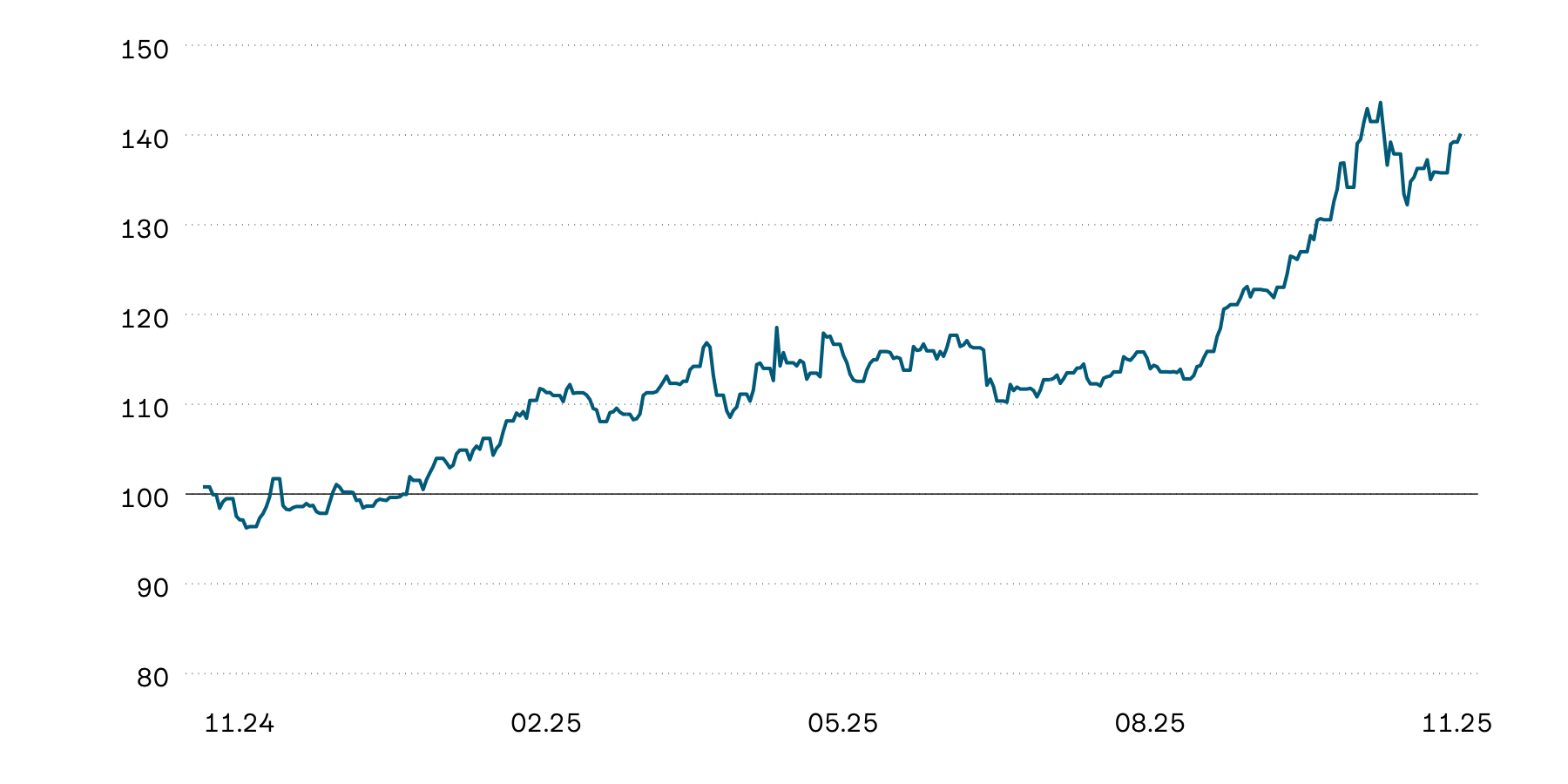
Gold continued its strong upward trend last month, reaching a new all-time high of just under 4,400 US dollars per troy ounce in the middle of the month. In particular, the escalating conflict between the USA and China over export controls on rare earth metals is likely to have driven gold prices to this peak at the start of the month. As the geopolitical situation eased, the gold price fell back slightly and has recently stabilized at around 4,200 US dollars per troy ounce. Overall, gold remains one of the strongest asset classes since the start of the year, with an increase in value of over 40 percent measured in Swiss francs.
